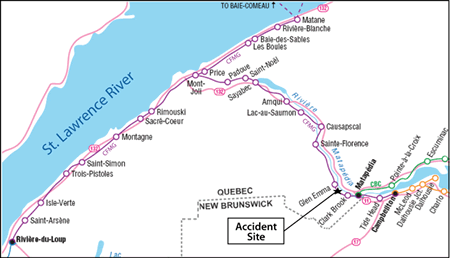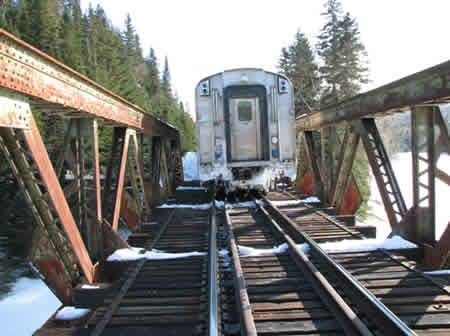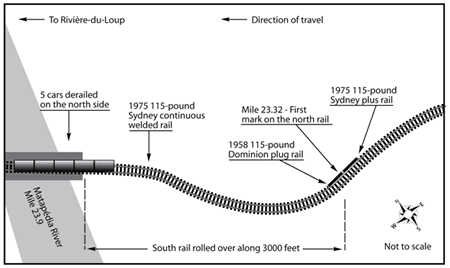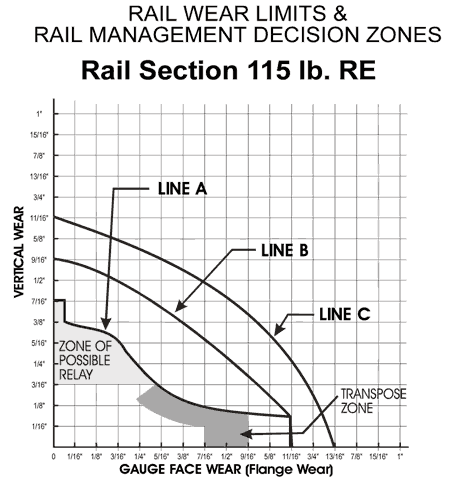Main-track derailment
VIA Rail Canada Inc.
Train number 15
Mile 23.32, Mont-Joli Subdivision
near Matapédia, Quebec
The Transportation Safety Board of Canada (TSB) investigated this occurrence for the purpose of advancing transportation safety. It is not the function of the Board to assign fault or determine civil or criminal liability. This report is not created for use in the context of legal, disciplinary or other proceedings. See Ownership and use of content. Masculine pronouns and position titles may be used to signify all genders to comply with the Canadian Transportation Accident Investigation and Safety Board Act (S.C. 1989, c. 3).
Summary
On 12 March 2008, at approximately 2215 eastern standard time, five cars of VIA Rail Canada Inc. train No. 15 travelling west to Rivière-du-Loup, Quebec, derailed at Mile 23.32 of the Mont-Joli Subdivision, near Matapédia, Quebec. The derailed cars sustained minor damage and about 3000 feet of track was damaged. There were no injuries and no damage to the environment.
Ce rapport est également disponible en français.
Factual information
On 12 March 2008, VIA Rail Canada Inc. (VIA) train No. 15 (the train) departed Campbellton, New Brunswick, at 2125 eastern standard timeFootnote 1 with 2 locomotives and 16 cars. It was about 1500-feet long and weighed approximately 1200 tons. It carried 10 senior service attendants and two locomotive engineers-one was the conductor and the other was at the controls (locomotive engineer). Both were qualified for their positions and met the rest and fitness requirements.
At Mile 23.32 of the Mont-Joli Subdivision (see Figure 1) on the Chemin de fer de la Matapédia et du Golfe (CFMG), when the train was travelling west at 42 mph, the locomotive engineer noticed that the train was not responding normally. He applied the service brakes gradually and stopped the train. Upon inspecting the train, the conductor found that the last five cars had derailed (12th car to 16th car). The rail traffic controller (RTC) was informed at 2215 and the passengers were transferred to the front of the train. The derailed cars were uncoupled and the train continued on its way to Montréal, Quebec.
The air temperature was -3°C. The ground was covered with compacted snow and only the top of the rail was visible. The derailed cars stopped on the subgrade at the east entrance of the bridge, which is 440 feet long and spans the Matapédia River. They stayed upright and coupled to the front of the train (see Photo 1).
The wheels of the cars sustained minor damage. The damage to the track started immediately in way of the derailed cars and continued into the curve to the Dominion plug rail located on the low rail (north) about 3000 feet east of the bridge. The head on the interior side of the plug rail was broken and fragments had come off. The 27-foot plug rail was made of 115-pound rail. It had been made in 1958, but its origin and installation date are unknown. On the west end, it had been flash-welded to the rest of the rail in the curve, which consisted of 115-pound RE Sydney continuous welded rail (CWR) from 1975. On the east end, it was bolted to another Sydney plug rail from 1975, which had been laid after a 26-inch-long vertical split head (VSH) defect was detected during rail testing on 10 April 2007 (see Figure 2). The track gauge 30 feet to the east was 57 ¼ inches, within the allowable limits set out in the Transport Canada-approved Railway Track Safety Rules (TSR).
CFMG, a subsidiary of the Quebec Railway Corporation, had acquired the Mont-Joli Subdivision from Canadian National (CN) in 1998. Since November 2008, the line has once again been under CN control. The subdivision stretches 190 miles, from Campbellton to Rivière-du-Loup, Quebec. It is a single main track. Rail traffic is controlled by the Occupancy Control System (OCS), pursuant to the Canadian Rail Operating Rules and CFMG special instructions, under the supervision of an RTC in Campbellton. The track was Class 4 according to the TSR; the maximum operating speed was 60 mph for freight trains and 70 mph for passenger trains. In the derailment area, the authorized speed was 45 mph for freight trains and 50 mph for passenger trains.
The track consisted primarily of CWR with 3200 hardwood ties per mile of track. Double-shouldered tie plates were used and secured with four spikes per tie. Every third tie had rail anchors.
The last geometry inspections were done in July and November 2007. Geometry defects were reported in the derailment area and were repaired immediately. The last bi-weekly visual inspection was conducted on 10 March 2008 by two track foremen on a hi-rail vehicle. No defects were observed in the derailment area.
According to the TSR, continuous testing for internal rail defects must be done once per year. However, since 2003, the frequency of testing had been increased to five times per year in the Mont-Joli Subdivision because of the age and wear of the rails. In 2007, only three tests were carried out (on April 10, July 4, and September 19) because of resource constraints encountered by the rail testing company. In the testing done on April 10 and September 19, between Mile 0 and Mile 55, 31 VSH defects were detected, including a few that were more than 300 inches long.
The TSB database shows that, over the past 10 years, there have been seven main-track derailments in the entire subdivision, with only one being caused by a rail failure (occurrence R04M0021).
Rail fracture
The detached fragments from the head and a segment including the Dominion plug rail and two feet of Sydney rail were recovered and sent to the TSB Engineering Laboratory for analysis (report LP 058/2008). The plug rail had a VSH defect 28 inches long on the interior side of the rail (see Photo 2) that started about 22 inches from the bolted end of the rail. A localized surface collapse (LSC) defect 26 inches long and 3/8 inch deep was observed 14 inches from the VSH defect.
Examination of the rail fragments affected by the VSH defect revealed the presence of rough fracture surfaces with chevron markings pointing to the point of origin of the fracture located in the largest fragment. At this point of origin of the fracture, several progressive crack markings oriented at about 45 degrees to the running surface and about halfway between the running surface and the gauge corner were observed. Inclusions of manganese sulphide and slight fatigue striations were identified.
The Dominion rail showed flattening and widening of the head along most of its length. In the area that was specifically affected by the LSC, extensive progressive cracking was observed with an orientation and position in relation to the running surface that were the same as those observed for the fracture due to the VSH defect. Friction areas were also observed in the progressive crack, as well as traces of rust.
The macroscopic examination revealed scattered signs of segregation in the head, as well as similar striations in the rail web on the specimens of the Dominion rail and the Sydney rail. The chemical analysis showed that both were carbon rails with a chemical composition that complied with CN standard 12-3A. They had a similar average Brinell hardness (HB) that matched the standard values found in carbon rails (250 to 278 HB).
Rail wear
According to observations by CFMG track maintenance employees, the frequency of VSH defects increases when rail head wear exceeds 11 to 12 mm. A 3D finite element analysis (FEA) was undertaken to evaluate how vertical head wear influences the stresses on the head. FEA models were defined according to four different degrees of vertical head wear: 0 mm, 8 mm, 12 mm, and 16 mm. Stress distribution in a rail head is very complex, and the model considered for FEA requirements used simplified wheel load support points and bearing points. The stresses and loads in this model therefore do not exactly represent those that are applied to a rail in service. Nevertheless, this model is considered suitable for carrying out a comparative analysis and provides qualitative information on how vertical wear influences the stresses on the rail head.
The FEA findings show that high local stresses are associated with the bearing point of the loads applied by the wheels. As the head is affected by vertical wear, the area of influence of these loads drops lower into the rail head. The analysis determined a point on the rail head where the stresses increased much faster once vertical head wear exceeded a value of about 10 mm. The stresses applied when wear reaches 16 mm are three to four times greater than the stresses applied when there is no wear.
In the curve at Mile 23.32, vertical head wear on the low rail was 12 mm and wear on the high rail was 15 mm. According to CN's Standard Practice Circular (SPC) 3200, 2004 editionFootnote 2, the vertical wear limit of 115-pound rail is 16 mm for CWR and 8 mm for bolted rails. SPC 3200 does not require replacement of the rail as long as the wear limit has not been reached. However, when wear exceeds the limit of 8 mm, low-profile joint bars must be used to avoid any contact between the wheel flange and joint bar. This requirement was not followed because wear caused by contact with the wheel flanges was observed on the plug rail joint bar and on other joint bars. Furthermore, the joint bars installed in the derailment area after the accident were not low profile and had damage caused by impact of the wheels.
With the exception of defective rail, CFMG changes rail only when wear exceeds the limits set out in SPC 3200, whereas the practice generally adopted by CN consists of replacing rail before the prescribed limits are reached when signs of fatigue appear. Other railway companies, such as Canadian Pacific Railway (CPR), specifically recommend in their standards that any rail that shows signs of fatigue be replaced, even if the wear is less than the stipulated limit. CPR standards state that the rail must be considered fatigued when, among rails of the same type and age laid in the same curve, certain specific defects, such as VSH defects, have appeared over the past 12 months (see Appendix A).
Analysis
When the locomotive engineer felt that the train was not responding normally, he did not use the emergency brakes, but instead applied the service brakes gradually to stop the train. This gentle braking minimized the dynamic forces generated in the train, and the derailed cars remained upright on the right-of-way and did not strike the bridge spanning the Matapédia River, which greatly reduced the seriousness of the derailment.
The condition of the rolling stock and operation of the train are not considered to be contributing factors in this accident. The analysis will therefore focus on the internal rail defects, rail wear, and track inspection.
Examination of the Dominion rail revealed the presence of a VSH and an LSC. The fracture surfaces showed inclusions of manganese sulphide and adjacent slight fatigue striations, which confirm that the rail was affected by pre-existing fatigue cracks at the location of the VSH and LSC. The cracks started in the inclusions of manganese sulphide and spread as fatigue defects in a 45-degree direction in relation to the running surface. As soon as the cracks reached a critical size, they spread in the vertical direction. Under the loads from the wheels, the interior part of the rail head detached, causing the cars to derail.
The flattening and widening of the head observed along most of the length of the Dominion rail suggest that the VSH had spread longitudinally beyond the sections of rail containing the VSH and LSC. In addition, the presence of rust and damage caused by friction in the fatigue cracks suggests that these defects had existed for some time.
The Dominion rail and the Sydney rail complied with the requirements of CN's standard 12-3A regarding chemical composition. The Brinell hardness values of the two rails were similar and matched the values that would be expected in standard carbon steel rails. In addition, the examination showed that the distribution of the inclusions and the quality of the steel were similar for both rails. Consequently, the formation of VSH defects in the Dominion rail did not result from metallurgical characteristics that were inferior to those of the Sydney rail.
Continuous testing of internal defects is the main method used by railway companies to detect internal rail defects and thereby limit the risks of derailment. Because of the age and wear of the rail, CFMG felt that it was necessary to increase the frequency of rail testing to five times a year, or every 10 weeks, whereas the TSR require testing only once a year. This practice seems to have been successful because there has only been one derailment caused by a rail failure in the subdivision in the past few years.
In 2007, because of resource constraints encountered by the rail testing company, testing was performed only three times, with the last one carried out almost 25 weeks before the accident. The cracks observed on the plug rail were rusted and must have been present for some time. More frequent testing would have created a better opportunity to detect the defect.
Although fatigue depends on many factors, the accumulated tonnage and stress range play a predominant role. Since the rail's origin and installation date are unknown, it is impossible to accurately determine the accumulated tonnage. However, the manufacture date, rail wear, and presence of internal defects suggest a high accumulated tonnage. In addition, the FEA showed that, as vertical wear of the head increases, the effects of stresses due to wheel contact affect the head at a greater depth. Moreover, the change in the properties of the section subject to this wear results in an increase in the overall stresses that affect the rail. Because rail wear results in an increase in stresses and reduces the rail's fatigue life, the rail becomes more susceptible to the development and spread of cracks.
In strict compliance with SPC 3200, CFMG does not consider fatigue and changes the rails only when wear exceeds the prescribed limits. Nevertheless, CN appears to recognize that fatigue is a factor to consider when replacing rails. The practice generally adopted by CN is replacing rails before the prescribed limits are reached when signs of fatigue appear. However, unlike CPR, there is no requirement to this effect in CN's standards and standard practices. Consequently, there is a risk that the affected employees are not informed of the practice adopted by CN and that it is not applied diligently and consistently.
SPC 3200 criteria requiring the use of low-profile joint bars when the wear limit exceeds 8 mm were not applied uniformly throughout the subdivision because wear and damage caused by wheel load impact were observed on several joint bars. Non-compliance with these criteria can result in wheel and rail failures, and can increase the risk of derailment.
Findings
Findings as to causes and contributing factors
- The train derailed subsequent to a rail failure due to vertical split head defects.
- The cracks started in the inclusions of manganese sulphide and spread as fatigue defects. When the cracks reached a critical size, they spread in the vertical direction and caused the rail failure.
- The cracks observed on the plug rail were rusted and must have been present for some time. Less frequent testing meant that an opportunity to detect the defect was lost.
Findings as to risks
- Because rail wear results in an increase in stresses and reduces a rail's fatigue life, a rail becomes more susceptible to the development and spread of cracks.
- Canadian National (CN) recognizes in practice that fatigue is a factor to consider when replacing rails; however, there is no requirement to this effect in CN's standards and standard practices. Consequently, there is a risk that the practice adopted by CN is not applied diligently and consistently.
- Non-compliance with Standard Practice Circular (SPC) 3200 criteria requiring the use of low-profile joint bars when the wear limit exceeds 8 mm can result in wheel and rail failures, and can increase the risk of derailment.
Other finding
- Because the locomotive engineer did not use the emergency brakes, but instead applied the service brakes gradually to stop the train, the dynamic forces generated in the train were minimized, thereby greatly reducing the seriousness of the derailment.
Safety action taken
On 20 June 2008, the TSB sent Rail Safety Advisory 04/08 to Transport Canada suggesting an examination of Chemin de fer de la Matapédia et du Golfe (CFMG) procedures for the inspection and replacement of worn rails in the Mont-Joli Subdivision and of the company's use of low-profile joint bars.
In July 2008, Transport Canada conducted an inspection between Mile 13 and Mile 107 of the Mont-Joli Subdivision and audited CFMG's inspection procedures. A notice related to the lack of documentation concerning the rail wear and the disuse of low-profile joint bars was issued on 18 July 2008 pursuant to section 31(1) of the Railway Safety Act. The notice will remain in effect until TC makes another inspection of the track, which is planned for the summer of 2009.
The acquisition of CFMG by Canadian National (CN) will allow rail testing to be conducted under CN's much larger service contracts. CN expects to conduct from six to eight rail flaw detection tests over this territory during 2009. Historical rail defects for the past two years will be integrated into CN's Rail Defect Index and Rail Severity Index systems, which use rail defect data to assign a severity level to a section of track. The joints connecting worn rails were identified, ground down, and painted blue to monitor them during inspections.
Shortly after acquiring the territory, CN's rail safety programs were extended and the track was examined by CN's test car on 11 November 2008. Rail locations exceeding the wear limits were protected pending replacement of the rails, while those approaching the limits were included on CN's Capital Program for 2009.
This report concludes the Transportation Safety Board's investigation into this occurrence. Consequently, the Board authorized the release of this report on .
Appendices
Appendix A - Canadian Pacific Railway wear limits
According to Canadian Pacific Railway (CPR) standards, a rail can be considered to have reached its fatigue limit when, in a curve, the rail exceeds the wear limits shown by Line A in the figure below, it is of the same type and the same age, and one of the following defects has been found in the past 12 months, or two have been found in the past 24 months:
- transverse fissure
- compound fissure
- detail fracture
- engine burn fracture
- horizontal split head
- vertical split head
- split web
- piped rail
- head-web separation




